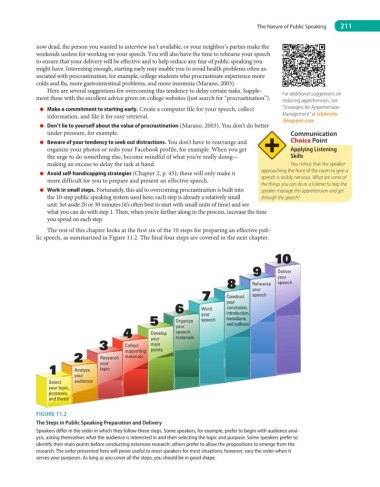Page 232 - Essentials of Human Communication
P. 232
The Nature of Public Speaking 211
now dead, the person you wanted to interview isn’t available, or your neighbor’s parties make the
weekends useless for working on your speech. You will also have the time to rehearse your speech
to ensure that your delivery will be effective and to help reduce any fear of public speaking you
might have. Interesting enough, starting early may enable you to avoid health problems often as-
sociated with procrastination; for example, college students who procrastinate experience more
colds and flu, more gastrointestinal problems, and more insomnia (Marano, 2003).
Here are several suggestions for overcoming this tendency to delay certain tasks. Supple- For additional suggestions on
ment these with the excellent advice given on college websites (just search for “procrastination”). reducing apprehension, see
● Make a commitment to starting early. Create a computer file for your speech, collect “Strategies for Apprehension
information, and file it for easy retrieval. Management” at tcbdevito
.blogspot.com.
● Don’t lie to yourself about the value of procrastination (Marano, 2003). You don’t do better
under pressure, for example. Communication
● Beware of your tendency to seek out distractions. You don’t have to rearrange and Choice Point
organize your photos or redo your Facebook profile, for example. When you get applying listening
the urge to do something else, become mindful of what you’re really doing— skills
making an excuse to delay the task at hand. You notice that the speaker
● Avoid self-handicapping strategies (Chapter 2, p. 45); these will only make it approaching the front of the room to give a
more difficult for you to prepare and present an effective speech. speech is visibly nervous. What are some of
the things you can do as a listener to help the
● Work in small steps. Fortunately, this aid to overcoming procrastination is built into speaker manage this apprehension and get
the 10-step public speaking system used here; each step is already a relatively small through the speech?
unit. Set aside 20 or 30 minutes (it’s often best to start with small units of time) and see
what you can do with step 1. Then, when you’re farther along in the process, increase the time
you spend on each step.
The rest of this chapter looks at the first six of the 10 steps for preparing an effective pub-
lic speech, as summarized in Figure 11.2. The final four steps are covered in the next chapter.
10
9 Deliver
8 Rehearse your
speech
7 Construct your
speech
6 Word your
conclusion,
introduction,
5 Organize your transitions,
speech
and outlines
4 Develop your
speech
materials
3 Collect your
main
points
2 Research supporting
materials
1 Analyze your
topic
your
Select audience
your topic,
purposes,
and thesis
figure 11.2
the steps in Public speaking Preparation and delivery
Speakers differ in the order in which they follow these steps. Some speakers, for example, prefer to begin with audience anal-
ysis, asking themselves what the audience is interested in and then selecting the topic and purpose. Some speakers prefer to
identify their main points before conducting extensive research; others prefer to allow the propositions to emerge from the
research. The order presented here will prove useful to most speakers for most situations; however, vary the order when it
serves your purposes. As long as you cover all the steps, you should be in good shape.

